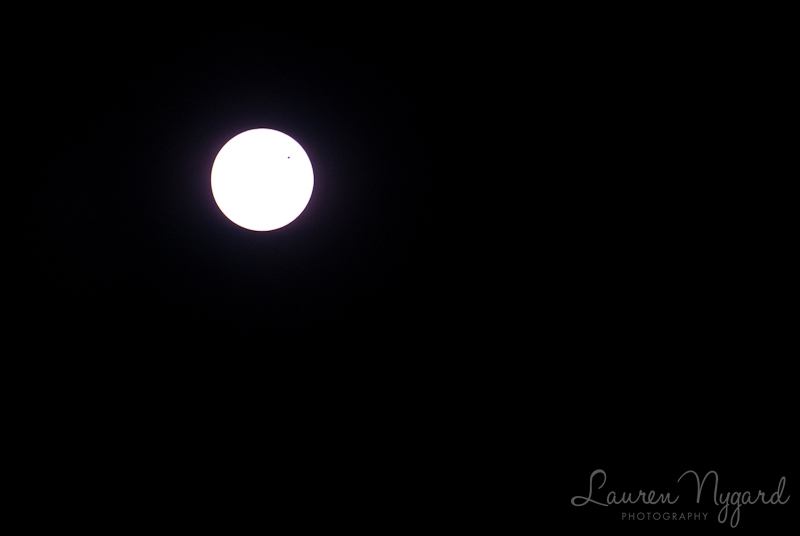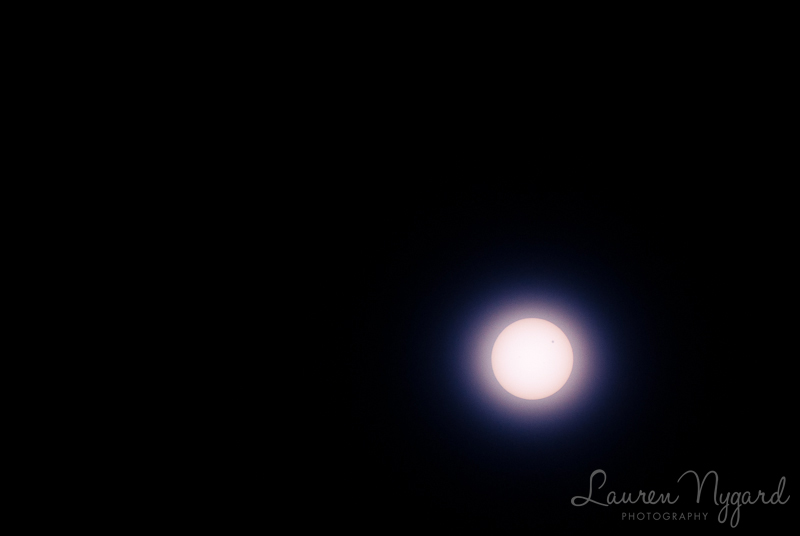If you’re sitting inside right now, get up, grab your favorite pair of solar eclipse glasses, and head outside right this second!
The Transit of Venus is happening right now and it’s really cool! Here’s the description from Wikipedia:
A transit of Venus across the Sun takes place when the planet Venus passes directly between the Sun and Earth, becoming visible against (and hence obscuring a small portion of) the solar disk. During a transit, Venus can be seen from Earth as a small black disk moving across the face of the Sun. The duration of such transits is usually measured in hours (the transit of 2004 lasted six hours). A transit is similar to a solar eclipse by the Moon. While the diameter of Venus is more than 3 times that of the Moon, Venus appears smaller, and travels more slowly across the face of the Sun, because it is much farther away from Earth.
Transits of Venus are among the rarest of predictable astronomical phenomena. They occur in a pattern that repeats every 243 years, with pairs of transits eight years apart separated by long gaps of 121.5 years and 105.5 years. The periodicity is a reflection of the fact that the orbital periods of Earth and Venus are close to 8:13 and 243:395 commensurabilities.
The next transit of Venus will occur on 5 and 6 June 2012, and will be the last Venus transit this century; the prior transit took place on 8 June 2004. The previous pair of transits were in December 1874 and December 1882. After 2012, the next transits of Venus will be in December 2117 and December 2125.
Venus transits are historically of great scientific importance as they were used to gain the first realistic estimates of the size of the Solar System. Observations of the 1639 transit, combined with the principle of parallax, provided an estimate of the distance between the Sun and the Earth that was more accurate than any other up to that time. In addition, the June 2012 transit will provide scientists with a number of other research opportunities, particularly in the refinement of techniques to be used in the search for exoplanets. A transit of Venus can be safely observed by taking the same precautions used to observe the partial phases of a solar eclipse. Staring at the Sun without appropriate eye protection can quickly cause serious and often permanent eye damage.
SAFETY NOTE: Do NOT attempt to look directly at the sun OR try to photograph the sun without proper equipment! Your eyes need special protection and so does your camera! I had made a special filter using aluminized mylar to photograph the solar eclipse last month, which is what I used to photograph the Transit of Venus today. If you look at the sun or try to photograph it without protection, your eyes and your camera will suffer irreversible damage! Just trust me on this one. Stay away unless you’re protected!
Pretty cool, huh?
(Yes, Venus is the little dot at the top, right side of the sun. You’re seeing it!)
Info for Photographers: The first image is straight from the camera (no editing except to add my logo). The second one is more purple because I was playing around with manual vs. auto focus, and it didn’t focus properly. The purple glow is due to the mylar filter I was using. I think it looks fun! :) I added a little contract to this one in Lightroom because you really can’t see Venus all that well. ;)
xoxo, Lauren





